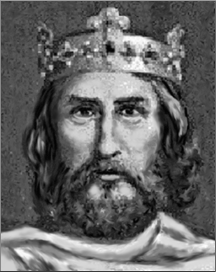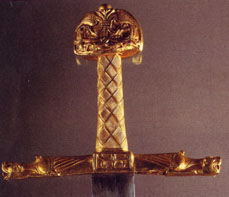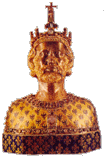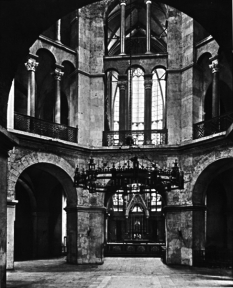 Charlemagne, King of the Franks
Charlemagne, King of the Franksand Emperor of the Holy Roman Empire Reigned: 768-814 c.742 - 814
In 772 Charlemagne began a campaign that lasted 30-years. He conquered and Christianized the powerful pagan Saxons of the north and subdued the Avars, a huge Tatar tribe on the Danube. He then compelled the rebellious Bavarian dukes to submit. However, he may have preferred settling disputes peacefully as exemplified by his offer to pay the Lombard king, Desiderius, for return of lands to the pope. But when Desiderius refused, Charlemagne seized the kingdom (773-774) and restored the Papal States by force.
To conduct a campaign he provided his military commanders (counts, princes, and bishops) with his demands for their manpower contributions, how to arm their soldiers, and a list of supplies for their supply wagons. A thousand years later, 1796-99, Napoleon relied on Charlemagne's methods to plan his own great sweeps through Europe, Egypt, and the Near East. In 1939-41 Germany used the Charlemagne model to blitzkrieg Europe. One of Charlemagne's minor campaigns became the most famous. In 778 he led his army into Spain to battle the infidel Saracens. During their return, Basques ambushed the rear guard at Roncesvalles in northern Spain and killed Count Roland. Roland became a great hero of medieval song and romance.
By establishing central government over Western Europe, Charlemagne restored much unity to what was the old Roman Empire and paved the way for the development of modern Europe. Crowned Emperor
Charlemagne is said to have been surprised by the coronation, declaring that he would not have come into the church had he known the pope's plan. However, some historians say the pope would not have dared to act without Charlemagne's knowledge. The coronation was the foundation of the Holy Roman Empire. Though Charlemagne did not use the title, he is considered the first Holy Roman emperor. Reform and Renaissance
Twice a year Charlemagne summoned the chief men of the empire to discuss its affairs. In all problems he was the final arbiter, even in church issues, and he largely unified church and state. Charlemagne was a tireless reformer who tried to improve his people's lot in many ways. He set up money standards to encourage commerce, tried to build a Rhine-Danube canal, and urged better farming methods. He especially worked to spread education and Christianity in every class of people. He revived the Palace School at Aachen, his capital. He set up other schools, opening them to peasant boys as well as nobles. Charlemagne never stopped studying. He brought an English monk, Alcuin, and other scholars to his court. He learned to read Latin and some Greek but apparently did not master writing. At meals, instead of having jesters perform, he listened to men reading from learned works. To revive church music, Charlemagne had monks sent from Rome to train his Frankish singers. To restore some appreciation of art, he brought valuable pieces from Italy. An impressive monument to his religious devotion is the cathedral at Aachen, which he built and where he was buried. At Charlemagne's death in 814 only one of his three sons, Louis, was living. Louis' weak rule brought on the rise of civil wars and revolts. After Louis' death, his three quarreling sons split the empire between them by the Partition of Verdun in 843. Charlemagne, page 1 > |
All rights reserved. For details and contact information: See License Agreement, Copyright Notice. |
 In 768, when Charlemagne was 26, he and his brother, Carloman, inherited the kingdom of the Franks but Carloman died three years later and Charlemagne became sole ruler. The northern half of Europe was pagan and lawless. In the south, the Roman Catholic church was striving to assert its power against the Lombard kingdom in Italy. Within Charlemagne's own realm, the Franks were barbaric tribes living dysfunctional lives in perpetual wars with each other.
In 768, when Charlemagne was 26, he and his brother, Carloman, inherited the kingdom of the Franks but Carloman died three years later and Charlemagne became sole ruler. The northern half of Europe was pagan and lawless. In the south, the Roman Catholic church was striving to assert its power against the Lombard kingdom in Italy. Within Charlemagne's own realm, the Franks were barbaric tribes living dysfunctional lives in perpetual wars with each other.
 Charlemagne's successes are attributable to his organizational skills. During his reign he initiated more than 50 major military expeditions and personally commanded at least half of them. He moved large armies over wide reaches of land at great speed, with every tactical and logistical detail carefully planned in advance.
Charlemagne's successes are attributable to his organizational skills. During his reign he initiated more than 50 major military expeditions and personally commanded at least half of them. He moved large armies over wide reaches of land at great speed, with every tactical and logistical detail carefully planned in advance.

 On Christmas Day 800, while Charlemagne knelt in prayer in Saint Peter's in Rome, Pope Leo III seized a golden crown from the altar and placed it on the bowed head of the king. The throng in the church shouted, "To Charles the August, crowned by God, great and pacific emperor, long life and victory!"
On Christmas Day 800, while Charlemagne knelt in prayer in Saint Peter's in Rome, Pope Leo III seized a golden crown from the altar and placed it on the bowed head of the king. The throng in the church shouted, "To Charles the August, crowned by God, great and pacific emperor, long life and victory!"
